Clement B. Newbold (1905–1984)
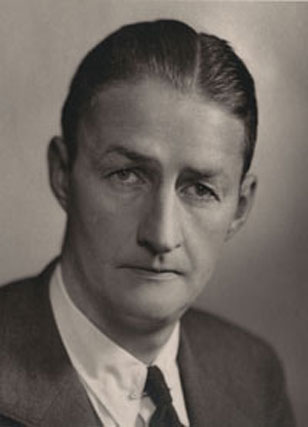
Clement B. Newbold
Academy Archives, 2010-302
While just a junior at Princeton in 1927, Clement B. Newbold established a fruitful relationship with the Academy. In that year, he financed an expedition to British Columbia to collect mammal specimens. He went by himself and had the assistance of two Native American guides. He kept a diary on that trip and also took photographs and movies. Included in the Academy’ archives are photographs with commentary on their fronts and backs which he sent to Witmer Stone, Ornithology Curator.
He shot and skinned three specimens of mountain goat (Oreamnos montanus), three specimens of mountain sheep (Ovis canadensis stonei), and two grizzly bears (Ursus arctos horribilis). The goats and the sheep appeared prominently in two Academy dioramas which were on display until the 1950s. Today, all of the goats and one of the sheep are on exhibit in Outside In, an Academy science exhibit just for children. The others are in exhibits storage. The grizzly bears were not mounted; the skins and skulls reside in the mammal collection. There are two letters in the Academy’ archives from C.M.B. Cadwalader, then on the Academy’ Board of Trustees, seeking prospective donors to fund the mounting of the six skins, praising Clement Newbold’ skill.
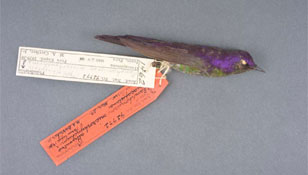
Purple-backed Thorntail
(Ramphomicron microrhynchum)
ANSP 92772, Holotype
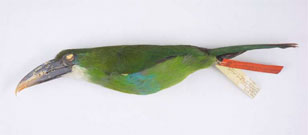
Blue-banded Toucanet
(Aulacorhynchus coeruleicinctis)
ANSP 91335, Holotype
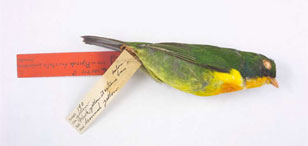
Scarlet-breasted Fruiteater
(Pipreola frontalis)
ANSP 101711, Holotype
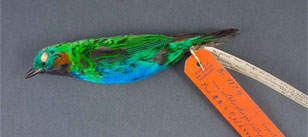
Oranged-eared Tanager
(Chlorochrysa calliparaea)
ANSP 91211, Holotype
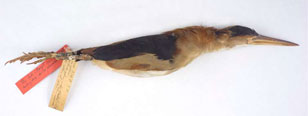
Peruvian Least Bittern
(Ixobrychus exilis)
ANSP 115899, Holotype
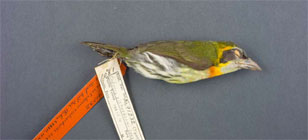
Lemon-throated Barbet
(Eubucco richardsoni)
ANSP 91232, Holotype
Two years later, Mr. Newbold financed the first of four collecting trips for the Ornithology Department to Peru (all made possible due to his generosity). He accompanied the noted collector Mel Carriker on the first trip in 1929-1930 as a collector and bird skinner. A total of 8,550 bird specimens were obtained on the four trips, making the Academy the premier collection of Andean birds. Of special importance is that 121 of those specimens were type specimens. A type specimen is the actual bird from which a new species is described and, thus, very precious. In the Academy’ archives is a letter from Mr. Newbold to Wharton Huber, Academy staff ornithologist, from Peru which talks about pictures he is taking and birds that have been collected.
Mr. Newbold also kept a diary in Peru. Almost exactly 90 years ago, on November 17, Clement Newbold wrote, “The fleas are devouring me in bed. Tomorrow, I shall crush up camphor and put it in my bed.” The camphor had no effect apparently. He was plagued the entire trip. His good humor, stoicism, and high expectations for himself are evidenced by his enthusiasm for skinning and collecting. On Nov. 21, he commented, “I did ten birds and got my time on most of them below 23 min.” On the 23rd, he had four hawks to do that were far from pleasant but an obvious challenge. Nate Rice, Collections Manager, estimates that close to half of the specimens obtained in 1929-30 were collected by Mr. Newbold.
His sharp eye for wildlife and the local culture fed his curiosity. On Dec. 9, he “collected a few orthoptera and studied some termites at work in their nest where I sliced into it.” He observed another traveler on his truck, on Nov. 24. “The lady with the squawking hen and flapping breast who got on in the valley was a scream; she alternated her attentions between the breast for her infant and attention for the chicken in the rear, at which time her breast swayed about filling all the extra space amongst us.” Though thoroughly absorbed in his Peruvian experience, he longed for mail from home and mentions writing letters to Anna, his sister, with whom he had traveled. On January 1, 1930, he expressed his stateside passion for the National Association of Amateur Oarsmen with a journal entry: “NEW YEARS DAY May you bring rowing triumphs”. Though devoured by fleas, Clement Newbold himself devoured his experiences with intense pleasure.
In 1932, an entirely new genus of snails, not just a species, was named for Mr. Newbold. As described in the Proceedings of the Academy (Vol. 84, 1932, pp. 387-88, 398-400), “The new genus Newboldius, proposed for certain rare and handsome Peruvian snails, is named in honor of Mr. Clement B. Newbold, to whose interest in the Peruvian zoological work of the Academy is chiefly due, and who, with Mr. M.A. Carriker, Jr., began the field work in Peru in 1929-30.”
It is impossible at this point to uncover Mr. Newbold’ connection to the Academy beyond the fourth collecting trip to Peru he sponsored in 1932-33. There is no further indication of contact with the Ornithology Department in the department’ records. Much of the Academy’ administrative records remain uncatalogued, so if he participated in other activities, the information is not at hand. Given his youthful enthusiasm for his collecting adventures, it is difficult to imagine that he cut his ties with the Academy. Filling out that later history will require future research.